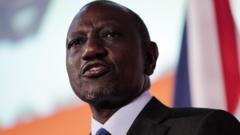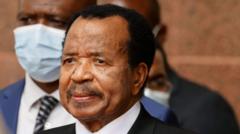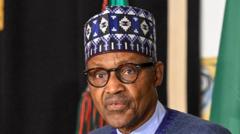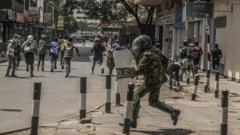Since taking office, President William Ruto of Kenya has witnessed unprecedented public backlash, marked by protests and calls for his resignation. Despite initial support, widespread discontent over issues like the rising cost of living and corruption has united citizens across various backgrounds, leading to increased scrutiny of Ruto's leadership.
Unprecedented Public Discontent: Is William Ruto the Most Disliked President in Kenya's History?

Unprecedented Public Discontent: Is William Ruto the Most Disliked President in Kenya's History?
As protests intensify and public sentiment sours, Kenya's President William Ruto faces growing criticism and calls for his resignation amid unprecedented discontent among Kenyans.
The article text:
William Ruto's presidency, which began with significant public enthusiasm and high hopes for transformative change, is now increasingly characterized by widespread discontent, leading many to ask if he is the most disliked president in Kenya's history. Since his election, the president has been the target of relentless public criticism, which seems to have reached heights previously unseen in the nation’s political landscape.
Frustrated by the public outcry, Ruto recently questioned why past leaders, such as Daniel arap Moi and others known for their heavy-handed rule, did not face similar scrutiny. His assertion, “Why wasn't it directed at Moi, Mwai Kibaki, Uhuru Kenyatta?” highlights his shock at the intensity of current sentiments. Analysts have characterized the ongoing turmoil—resulting in over ten fatalities this year alone—as "unprecedented," uniting Kenyans from various ethnic, religious, and socioeconomic backgrounds in their grievances.
The protests, which erupted just a year following Ruto's inauguration, have intensified to the point where cries of "Ruto must go" resonate across the nation. Once perceived as a man of the people—drawing on his own hard-fought rise from poverty to presidency—Ruto is now increasingly viewed as detached from the everyday lives of ordinary Kenyans. A recent headline in a local newspaper posed the provocative question: Is Ruto "Kenya's most hated president?" indicating a tectonic shift in public perception.
This sentiment was reflected on social media, where the phrase "We are all Kikuyus" gained traction, suggesting a desire to transcend historic ethnic divides that have governed the country's political climate. Yet a counter-narrative of "We are all Kenyans" struggled to gain similar momentum, indicating a fracture within the collective consciousness of the populace.
The Kikuyu community, having overwhelmingly supported Ruto in the last election, experienced significant disillusionment in the wake of political betrayals, including the impeachment of deputy Rigathi Gachagua. Some factions within Ruto's administration pointed to Kikuyu elites as culprits in undermining the presidency. However, political commentator Mark Bichachi argues the dissent against Ruto transcends ethnic lines, gaining momentum across communities in both urban and rural areas.
Those opposing Ruto cite long-standing frustrations over rising commodity prices, aggressive taxation, and corruption that have manifested through widespread youth-led movements, often coordinated through social media. As Dr. Njoki Wamai remarked, while criticism of leaders is a fixture in Kenyan politics, the current scale of discontent is likely magnified by digital connectivity among younger voters who have a different set of expectations.
Ruto's administration has faced severe backlash for its often violent responses to dissent; rights organizations report instances of excessive police force, resulting in a further alienation of citizens. Despite asserting plans to introduce comprehensive social reforms, the perceived disconnect between Ruto's ambitious promises and the reality faced by many Kenyans has fueled growing frustration, encapsulated in sentiments of betrayal among those who once heralded him as a transformative leader.
Recent violent protests underscore the growing rift between the presidency and the citizenry, with security operations accused of heavy-handedness leading to rising fatalities. Such governance methods, instead of promoting administration reform, have often ignited further outbursts of public anger—turning grief into rebellion.
Political communication expert Hesbon Owilla suggests that Ruto’s downfall is fueled in part by the manner of his promises, which have left many waiting in vain for tangible outcomes. His failure to meet these expectations is creating a sense of collective rage among Kenyans, aggravated further by a backdrop of high living costs and inadequate governance.
While Ruto defiantly pledged progress, citing initiatives meant to address unemployment and housing as indicators of his government’s efforts, Kenyans remain impatient, mired in a perception that rising taxation is not yielding improved public services. Although some initiatives may demonstrate potential for future impact, the pressing issues of the present overshadow such prospects, leaving the public questioning the effectiveness of Ruto’s leadership amid their ongoing discontent.
As the scenario evolves, analysts declare this moment to be historic—pitting the people against a leader whose initial acclaim has given way to acute dissatisfaction. Ruto's administration stands at a critical juncture, navigating a political landscape charged with disillusionment and rampant protest, as Kenyans demand accountability and change.
William Ruto's presidency, which began with significant public enthusiasm and high hopes for transformative change, is now increasingly characterized by widespread discontent, leading many to ask if he is the most disliked president in Kenya's history. Since his election, the president has been the target of relentless public criticism, which seems to have reached heights previously unseen in the nation’s political landscape.
Frustrated by the public outcry, Ruto recently questioned why past leaders, such as Daniel arap Moi and others known for their heavy-handed rule, did not face similar scrutiny. His assertion, “Why wasn't it directed at Moi, Mwai Kibaki, Uhuru Kenyatta?” highlights his shock at the intensity of current sentiments. Analysts have characterized the ongoing turmoil—resulting in over ten fatalities this year alone—as "unprecedented," uniting Kenyans from various ethnic, religious, and socioeconomic backgrounds in their grievances.
The protests, which erupted just a year following Ruto's inauguration, have intensified to the point where cries of "Ruto must go" resonate across the nation. Once perceived as a man of the people—drawing on his own hard-fought rise from poverty to presidency—Ruto is now increasingly viewed as detached from the everyday lives of ordinary Kenyans. A recent headline in a local newspaper posed the provocative question: Is Ruto "Kenya's most hated president?" indicating a tectonic shift in public perception.
This sentiment was reflected on social media, where the phrase "We are all Kikuyus" gained traction, suggesting a desire to transcend historic ethnic divides that have governed the country's political climate. Yet a counter-narrative of "We are all Kenyans" struggled to gain similar momentum, indicating a fracture within the collective consciousness of the populace.
The Kikuyu community, having overwhelmingly supported Ruto in the last election, experienced significant disillusionment in the wake of political betrayals, including the impeachment of deputy Rigathi Gachagua. Some factions within Ruto's administration pointed to Kikuyu elites as culprits in undermining the presidency. However, political commentator Mark Bichachi argues the dissent against Ruto transcends ethnic lines, gaining momentum across communities in both urban and rural areas.
Those opposing Ruto cite long-standing frustrations over rising commodity prices, aggressive taxation, and corruption that have manifested through widespread youth-led movements, often coordinated through social media. As Dr. Njoki Wamai remarked, while criticism of leaders is a fixture in Kenyan politics, the current scale of discontent is likely magnified by digital connectivity among younger voters who have a different set of expectations.
Ruto's administration has faced severe backlash for its often violent responses to dissent; rights organizations report instances of excessive police force, resulting in a further alienation of citizens. Despite asserting plans to introduce comprehensive social reforms, the perceived disconnect between Ruto's ambitious promises and the reality faced by many Kenyans has fueled growing frustration, encapsulated in sentiments of betrayal among those who once heralded him as a transformative leader.
Recent violent protests underscore the growing rift between the presidency and the citizenry, with security operations accused of heavy-handedness leading to rising fatalities. Such governance methods, instead of promoting administration reform, have often ignited further outbursts of public anger—turning grief into rebellion.
Political communication expert Hesbon Owilla suggests that Ruto’s downfall is fueled in part by the manner of his promises, which have left many waiting in vain for tangible outcomes. His failure to meet these expectations is creating a sense of collective rage among Kenyans, aggravated further by a backdrop of high living costs and inadequate governance.
While Ruto defiantly pledged progress, citing initiatives meant to address unemployment and housing as indicators of his government’s efforts, Kenyans remain impatient, mired in a perception that rising taxation is not yielding improved public services. Although some initiatives may demonstrate potential for future impact, the pressing issues of the present overshadow such prospects, leaving the public questioning the effectiveness of Ruto’s leadership amid their ongoing discontent.
As the scenario evolves, analysts declare this moment to be historic—pitting the people against a leader whose initial acclaim has given way to acute dissatisfaction. Ruto's administration stands at a critical juncture, navigating a political landscape charged with disillusionment and rampant protest, as Kenyans demand accountability and change.



















